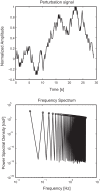Changes in sensory reweighting of proprioceptive information during standing balance with age and disease
- PMID: 26424578
- PMCID: PMC4686291
- DOI: 10.1152/jn.00414.2015
Changes in sensory reweighting of proprioceptive information during standing balance with age and disease
Abstract
With sensory reweighting, reliable sensory information is selected over unreliable information during balance by dynamically combining this information. We used system identification techniques to show the weight and the adaptive process of weight change of proprioceptive information during standing balance with age and specific diseases. Ten healthy young subjects (aged between 20 and 30 yr) and 44 elderly subjects (aged above 65 yr) encompassing 10 healthy elderly, 10 with cataract, 10 with polyneuropathy, and 14 with impaired balance, participated in the study. During stance, proprioceptive information of the ankles was disturbed by rotation of the support surface with specific frequency content where disturbance amplitude increased over trials. Body sway and reactive ankle torque were measured to determine sensitivity functions of these responses to the disturbance amplitude. Model fits resulted in a proprioceptive weight (changing over trials), time delay, force feedback, reflexive stiffness, and damping. The proprioceptive weight was higher in healthy elderly compared with young subjects and higher in elderly subjects with cataract and with impaired balance compared with healthy elderly subjects. Proprioceptive weight decreased with increasing disturbance amplitude; decrease was similar in all groups. In all groups, the time delay was higher and the reflexive stiffness was lower compared with young or healthy elderly subjects. In conclusion, proprioceptive information is weighted more with age and in patients with cataract and impaired balance. With age and specific diseases the time delay was higher and reflexive stiffness was lower. These results illustrate the opportunity to detect the underlying cause of impaired balance in the elderly with system identification.
Keywords: elderly; proprioception; sensory reweighting; standing balance; system identification techniques.
Copyright © 2015 the American Physiological Society.
Figures







References
-
- Allison LK, Kiemel T, Jeka JJ. Multisensory reweighting of vision and touch is intact in healthy and fall-prone older adults. Exp Brain Res 175: 342–352, 2006. - PubMed
-
- Barin K, Dodson EE. Dizziness in the elderly. Otolaryngol Clin North Am 44: 437–454, 2011. - PubMed
-
- Barrett MM, Doheny EP, Setti A, Maguinness C, Foran TG, Kenny RA, Newell FN. Reduced vision selectively impairs spatial updating in fall-prone older adults. Multisens Res 26: 69–94, 2013. - PubMed
-
- Black AA, Wood JM, Lovie-Kitchin JE, Newman BM. Visual impairment and postural sway among older adults with glaucoma. Optom Vis Sci 85: 489–497, 2008. - PubMed
Publication types
MeSH terms
LinkOut - more resources
Full Text Sources
Other Literature Sources
Medical

